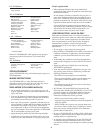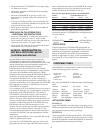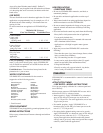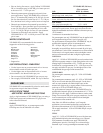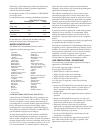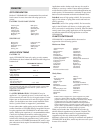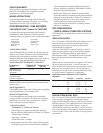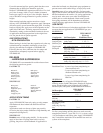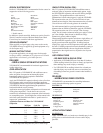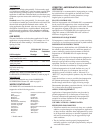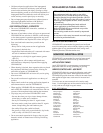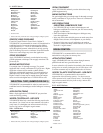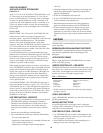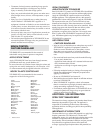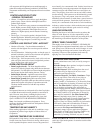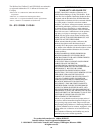
WESTERN US
Rainbelt (areas of high spring rainfall): For best results, apply
as a broadcast or banded spray in the late winter or spring when
weeds are actively growing, but prior to conifer budbreak. If
application is made after conifer bud break, use directional spray
equipment to prevent contact with conifer foliage, as injury may
result.
Snowbelt (areas of low spring rainfall): For best results, apply
as a broadcast or banded spray in the fall before soil freezes and
after the final resting bud has hardened on the conifers. Or,
spring applications may be made after snow cover melts in
anticipation of rainfall prior to conifer budbreak. Weed control
results from spring treatments will be dependent on sufficient
rainfall following application to activate DuPont™ VELPAR®
DF.
USE RATES
The rates listed below are for broadcast application. For band
application, use proportionately less. For example, use 1/2 of
the broadcast rates when treating a 3-foot band where row
spacing is 6 feet.
EASTERN US
VELPAR® DF (Lb/Acre)
First Year Established
Soil Description Plantings Trees
Loamy sand, 1 1/3 1 1/3 - 1 2/3
sandy loam(50-85% sand)
Loam, silt loam, silt, 1 1/3 - 1 1/2 1 2/3 - 2 1/3
sandy clay loam
Silty clay loam, 1 1/2 - 1 8/10 2 1/3 - 2 2/3
clay loam, sandy clay,
silty clay, clay
Red pine only - Refer to recommended rates in the
HARDWOOD SUPPRESSION - Eastern US table on page 11.
WESTERN US
Refer to recommended rates in the HARDWOOD
SUPPRESSION-Western US table on page 11.
WEEDS CONTROLLED
VELPAR® DF is recommended for the control or
suppression of the following species:
* Partial control
FORESTRY—IMPREGNATION ON DRY BULK
FERTILIZER
VELPAR® DF is recommended for impregnating or coating
dry bulk fertilizer to be applied on forested sites for the
establishment or release of conifer plantations (except
longleaf pine) as specified on this label.
PLANTS CONTROLLED
Fertilizer impregnated with VELPAR® DF is recommended
for the control and suppression of the weeds and brush
identified for the specific applications on this label. Consult
the appropriate segment of this label to determine the
appropriate rate of VELPAR® DF to be applied per acre.
Apply this amount of VELPAR® DF to the volume of
fertilizer to be applied per acre.
IMPREGNATION EQUIPMENT
To impregnate or coat the fertilizer use a system consisting
of conveyor or closed drum used to blend dry bulk fertilizer.
IMPREGNATION INSTRUCTIONS
To impregnate dry bulk fertilizer with VELPAR® DF, mix
the amount as prescribed above in a sufficient quantity of
water to uniformly coat the desired amount of fertilizer.
Suspensions of VELPAR® DF will require thorough
agitation.
Direct the spray nozzles of the impregnation equipment to
deliver a fine spray of the mixture toward the fertilizer for
thorough coverage while avoiding contact with mixing
equipment. The use of a colorant or dye may be beneficial
to visually determine the uniformity of impregnation.
Uniform impregnation of dry bulk fertilizer may vary. If
absorption of the spray is not adequate, the use of an
absorptive powder or additive, such as “Microcel E” or
“HiSil 233”, may be required to produce a dry, free flowing
mixture.
Apply the fertilizer as soon as possible after impregnation
for optimum performance. Impregnated fertilizer may
become lumpy and difficult to apply following storage.
Diammonium phosphate, potassium chloride, 16-16-16 and
24-4-4 have been successfully impregnated.
APPLICATION EQUIPMENT
Applications of impregnated fertilizer may be made by
ground equipment or by air (helicopter or fixed wing).
Accurate calibration and patterning of the equipment is
essential for uniform distribution of the impregnated
fertilizer on the soil surface.
USE PRECAUTIONS—IMPREGNATED
FERTILIZER FOR FORESTRY
• If fertilizer materials are excessively dusty, use a suitable
additive to reduce dust prior to impregnation. Application
of dusty fertilizer which has been impregnated may result
in off-target drift and injury to desirable vegetation. Such
drift and associated injury may be aggravated by high
wind conditions.
• The dry fertilizer must be properly impregnated and
uniformly applied to avoid pine injury/mortality and poor
weed and brush control.
Annual bluegrass
Aster
Barnyardgrass
Bentgrass
Bracken Fern
Bromegrass
Catsear (false dandelion)
Common groundsel
Common ragweed
Crabgrass*
Curly dock*
Dandelion*
Dogfennel
Fescue*
Fireweed (willowweed)*
Fleabane
Foxtail
Goldenrod*
Heath aster*
Horseweed*
Orchardgrass*
Oxeye daisy
Panicums
Pennsylvania smartweed
Ryegrass*
Squawcarpet
Velvetgrass
Wild carrot*
13



